Calit2 Showcases Efforts in Computer Graphics at SIGGRAPH 2003
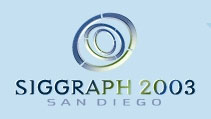 8.7.03 - Calit² and affiliated faculty and researchers from UC San Diego and UC Irvine participated in force at the 30th anniversary of SIGGRAPH (short for "Special Interest Group: Graphics"), the premier annual conference on computer graphics and interactive techniques. It took place in San Diego July 27-31, and an estimated 25,000 people attended the conference or concurrent trade show at the San Diego Convention Center. Representatives from Calit²'s New Media Arts layer as well as other faculty on the two campuses organized special courses, delivered papers, showcased new graphics techniques, and showed works in the SIGGRAPH Art Gallery.
8.7.03 - Calit² and affiliated faculty and researchers from UC San Diego and UC Irvine participated in force at the 30th anniversary of SIGGRAPH (short for "Special Interest Group: Graphics"), the premier annual conference on computer graphics and interactive techniques. It took place in San Diego July 27-31, and an estimated 25,000 people attended the conference or concurrent trade show at the San Diego Convention Center. Representatives from Calit²'s New Media Arts layer as well as other faculty on the two campuses organized special courses, delivered papers, showcased new graphics techniques, and showed works in the SIGGRAPH Art Gallery.
Papers
An international jury of specialists applied rigorous criteria in selecting 82 papers for presentation and publication at SIGGRAPH 2003. Apart from traditional topics, this year's papers dealt with the intersection of computer graphics and a host of other disciplines including computer vision, games, robotics and medicine.
UCSD computer science and engineering professors Serge Belongie and Henrik Wann Jensen, together with grad student Sameer Agarwal and Columbia University assistant professor of computer science Ravi Ramamoorthi, published "Structured Importance Sampling of Environment Maps" in the conference proceedings. In the paper, the authors introduce a new technique for more efficiently rendering scenes that feature distant natural illumination (see image below). Called "structured importance sampling," the technique is significantly faster than the most common sampling methods used in the computer-graphics industry today -- requiring one to two orders of magnitude fewer samples for the same image quality. The technique could speed up the work of Hollywood special-effects wizards and videogame developers. [More]

Jensen is also the co-author of a second paper selected by the judges for publication: "Light Scattering from Human Hair Fibers." Jensen and colleagues at Stanford, Cornell and Worley Laboratories made new measurements of light scattering from individual hair fibers. Those measurements found some of the light bouncing off of the hair fibers at angles that were not consistent with today's most widely used simulation algorithms. In the paper, Jensen et. al. propose a practical shading model for hair that qualitatively matches the scattering behavior they measured - effectively producing a new model for simulating the behavior of light on hair (middle image below, compared to previous method at left and the real hair to the right). [More]
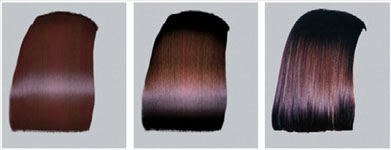
Courses
SIGGRAPH 2003 offered a full range of half- and full-day courses designed to expose attendees to the latest trends and technologies. The 45 courses were selected from a record 111 submissions.
Calit²'s UC Game Culture & Technology Lab presented "Fun & Games: Art-Based Game Modding". The event was organized and co-moderated by Celia Pearce, Associate Director of the Game Lab at UC Irvine, and Carol Hobson, Arts Research Manager at UCSD's Center for Research in Computing and the Arts (CRCA). Also presenting were the Game Lab's director, UC Irvine professor Robert Nideffer, an expert in game art and modding, Brody Condon, and Sky Frostenson, a recent UCSD grad who is entering into UCI's Arts Computation and Engineering (ACE) program this fall. Game modding, or "modification," has revolutionized the computer game world by making the use of consumer-grade, real-time 3D game engines available to creative gamers. A new generation of digital media artists has harnessed the engines to create bold new forms of virtual reality for the PC environment. The presentations included an overview of the cultural role of games and the new generation of gamers who have embraced game art as a legitimate form of artistic expression. The session closed with a lively and provocative discussion with attendees, including such topics as political content of games, narrative content, and gender bias of game-making tools. [More]
Another Calit² participant, Mike Bailey -- director of the San Diego Supercomputer Center's Design Visualization Lab -- organized and co-taught an "Introduction to Computer Graphics." The full-day course covered topics including how computer graphics works at the hardware and software levels, as well as application areas such as modeling, rendering, animation, visualization, graphics on the Web, and virtual reality.
 Mike Bailey was also one of the lecturers in a half-day course that provided an introduction to 3D layered manufacturing: "3D Hardcopy: Converting Virtual Reality to Physical Models." The course explained the processes that commercial systems use to build 3D parts, and which technologies are most appropriate for different geometries and applications. It also covered software techniques for transforming a VR model into realizable geometry, and a process plan for a layered-manufacturing system (see model of heart at right). Bailey runs the supercomputer center's Tele-Manufacturing Facility, and is an adjunct professor at UCSD's Jacobs School of Engineering.
Mike Bailey was also one of the lecturers in a half-day course that provided an introduction to 3D layered manufacturing: "3D Hardcopy: Converting Virtual Reality to Physical Models." The course explained the processes that commercial systems use to build 3D parts, and which technologies are most appropriate for different geometries and applications. It also covered software techniques for transforming a VR model into realizable geometry, and a process plan for a layered-manufacturing system (see model of heart at right). Bailey runs the supercomputer center's Tele-Manufacturing Facility, and is an adjunct professor at UCSD's Jacobs School of Engineering.
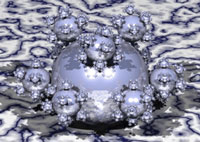 Henrik Jensen also organized a full-day course on "Monte Carlo Ray Tracing". He and five other researchers, including UC Irvine computer science professor James Arvo, gave attendees a detailed overview of the state of the art, with a focus on realistic image synthesis and global illumination. They covered topics including basic Monte Carlo integration, variance reduction techniques, path tracing and bidirectional path tracing.
Henrik Jensen also organized a full-day course on "Monte Carlo Ray Tracing". He and five other researchers, including UC Irvine computer science professor James Arvo, gave attendees a detailed overview of the state of the art, with a focus on realistic image synthesis and global illumination. They covered topics including basic Monte Carlo integration, variance reduction techniques, path tracing and bidirectional path tracing.
Sketches & Applications
 Over 170 examples of breakthrough imaging, adventurous techniques, and amazing effects were on display in roughly 40 sessions under SIGGRAPH 2003's Sketches & Applications banner. Presenters previewed their most recent achievements in animation, art, artificial intelligence, display devices, gaming, and other areas. Here again, Henrik Jensen represented UCSD and Calit² with a technical sketch in the Faces category called "Digital Face Cloning" (image at right). The process and the technology was used in the creation of a digital clone of a human face for a story about skin in National Geographic magazine.
Over 170 examples of breakthrough imaging, adventurous techniques, and amazing effects were on display in roughly 40 sessions under SIGGRAPH 2003's Sketches & Applications banner. Presenters previewed their most recent achievements in animation, art, artificial intelligence, display devices, gaming, and other areas. Here again, Henrik Jensen represented UCSD and Calit² with a technical sketch in the Faces category called "Digital Face Cloning" (image at right). The process and the technology was used in the creation of a digital clone of a human face for a story about skin in National Geographic magazine.
UCSD computer science professor David Kriegman, another Calit² participant, was selected to show in the Textures category. His "Fast Texture Synthesis on Arbitrary Meshes" (co-authored by Sebastian Magda of the University of Illinois at Urbana-Champaign) was produced with the generation of high-quality textures on arbitrary meshes in a matter of seconds. The result of this fully automatic, user-controllable process is a mapping of every triangle in a mesh to the original texture sample - with no need for additional texture memory.
In the Rendering category, three researchers from UC Irvine led by Information & Computer Science professor Renato Pajarola showcased a technique called "Object-Space Point Blending and Splatting." It is a novel point-based rendering approach based on object-space point interpolation of densely sampled surfaces (image below). Experimental results displayed at SIGGRAPH show the high quality and rendering efficiency that is achieved by this approach. Also involved in the project: UC Irvine mathematics professor Patrick Guidotti, and graduate student Miguel Sainz. The point-based rendering system was also showcased in the Exhibition at the NVIDIA booth. [More]
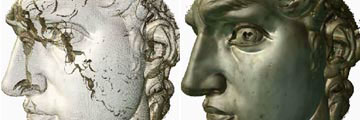
Art Gallery
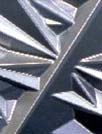 To reflect SIGGRAPH's 30th anniversary, this year's Art Gallery returned to the computer graphics industry's roots, with an emphasis on digital prints, sculpture, and the growing impact of digital video and animation. Some 269 pieces were selected from three times as many submissions. UCSD visual arts professor Sheldon Brown, who is also Calit²'s New Media Arts layer leader at UCSD, showed two of the pieces from his Istoria sculpture series. The wall-relief sculptures (at right) were created using computer-controlled modeling. [More]
To reflect SIGGRAPH's 30th anniversary, this year's Art Gallery returned to the computer graphics industry's roots, with an emphasis on digital prints, sculpture, and the growing impact of digital video and animation. Some 269 pieces were selected from three times as many submissions. UCSD visual arts professor Sheldon Brown, who is also Calit²'s New Media Arts layer leader at UCSD, showed two of the pieces from his Istoria sculpture series. The wall-relief sculptures (at right) were created using computer-controlled modeling. [More]
Special Events
 Calit² layer leader Brown also hosted a Computing Arts Café at CRCA. As one of SIGGRAPH's "Birds of a Feather" events, the evening reception was designed to bring like-minded groups together - in this case, digital and computing artists. The café showcased digital videos, Internet performance, software installation and VJ/DJ sets by artists including Sheldon Brown, Harold Cohen, Jordan Crandall, Amy Alexander, Eduardo Navas, Brody Condon, Lisa Hutton, Carol Hobson, Ted Apel, Matt Hope, Jonathan Phillips, Neil Stuber, Rachel Beth Egenhoefer, Joel Swanson, Phillip Sharpe and Brad Borevitz (whose "Harmona.7a.4" generative flash installation is pictured at right). [More]
Calit² layer leader Brown also hosted a Computing Arts Café at CRCA. As one of SIGGRAPH's "Birds of a Feather" events, the evening reception was designed to bring like-minded groups together - in this case, digital and computing artists. The café showcased digital videos, Internet performance, software installation and VJ/DJ sets by artists including Sheldon Brown, Harold Cohen, Jordan Crandall, Amy Alexander, Eduardo Navas, Brody Condon, Lisa Hutton, Carol Hobson, Ted Apel, Matt Hope, Jonathan Phillips, Neil Stuber, Rachel Beth Egenhoefer, Joel Swanson, Phillip Sharpe and Brad Borevitz (whose "Harmona.7a.4" generative flash installation is pictured at right). [More]
Exploring how computer graphics and interactive techniques can be used in community education and communication, the San Diego professional chapter of ACM SIGGRAPH presented software projects, web sites, video, and collaborative systems at San Diego's Computer Museum of America. The 11th annual sigKIDS juried competition drew entries from academic partners of Calit² including the Preuss School at UCSD and SDSC's Educational Technology Laboratory. The competition was designed to recognize computer visualization projects that promote the development of multi-sensory interactions, multilingual formats, lifetime learning, and interdisciplinary approaches.
 Among the prizewinners: Alan Lu, an 11th grader at the Preuss School on the UCSD campus, for his interactive tutorial designed to teach students how to solve basic algebraic equations; and John Barta, a math specialist at Balboa Elementary School who designed a learning game called "Bowling with Numbers" (pictured at right) while attending SDSC's TeacherTECH training program last summer. The Web-based game generates sets of three random numbers, which students then use in mathematical expressions they write themselves. Correct answers are rewarded by pins being knocked down in the bowling game. An SDSC-designed K-12 curriculum development project "EnVision Explore Engage" also won an award. "These awards show the excellence of both the training and educational programs at the Supercomputer Center," says Rozeanne Steckler, director of the SDSC Education Department, who also does K-12 education and outreach for Calit². "In the case of John Barta's award for his TeacherTECH project, it shows that in a two-week course we can give skills to teachers who otherwise know very little about information technology, and these skills can enable them to develop an award-winning piece of curriculum." [More]
Among the prizewinners: Alan Lu, an 11th grader at the Preuss School on the UCSD campus, for his interactive tutorial designed to teach students how to solve basic algebraic equations; and John Barta, a math specialist at Balboa Elementary School who designed a learning game called "Bowling with Numbers" (pictured at right) while attending SDSC's TeacherTECH training program last summer. The Web-based game generates sets of three random numbers, which students then use in mathematical expressions they write themselves. Correct answers are rewarded by pins being knocked down in the bowling game. An SDSC-designed K-12 curriculum development project "EnVision Explore Engage" also won an award. "These awards show the excellence of both the training and educational programs at the Supercomputer Center," says Rozeanne Steckler, director of the SDSC Education Department, who also does K-12 education and outreach for Calit². "In the case of John Barta's award for his TeacherTECH project, it shows that in a two-week course we can give skills to teachers who otherwise know very little about information technology, and these skills can enable them to develop an award-winning piece of curriculum." [More]
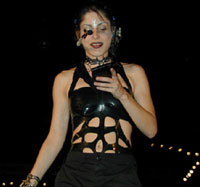 Finally, Calit2 Scholar Alex Lightman organized (with Isa Gordon) the Second Annual SIGGRAPH CyberFashion Show. Lightman is also the CEO of Charmed Technology, a company specializing in wearable computers. The one-hour show drew more than 850 attendees, who were treated to a runway show of more than 50 outfits featuring virtual-reality garb, wearable computers and displays, high-tech carrying cases, so-called "smart" clothes, luminous clothing and accessories, as well as CAD/CAM jewelry and bodywear. Photo courtesy Kiristen Massie & Lyn Bishop. [More]
Finally, Calit2 Scholar Alex Lightman organized (with Isa Gordon) the Second Annual SIGGRAPH CyberFashion Show. Lightman is also the CEO of Charmed Technology, a company specializing in wearable computers. The one-hour show drew more than 850 attendees, who were treated to a runway show of more than 50 outfits featuring virtual-reality garb, wearable computers and displays, high-tech carrying cases, so-called "smart" clothes, luminous clothing and accessories, as well as CAD/CAM jewelry and bodywear. Photo courtesy Kiristen Massie & Lyn Bishop. [More]

